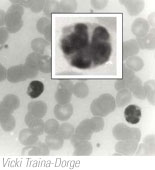 |
||||
STLV and HTLV
Collaborative studies on HTLV include the experimental transmission of human clinical isolates of HTLV-I to nonhuman primates. In certain geographic regions, HTLV co-infection of HIV-I positive individuals has a prevalence of 5-10%, and is hypothesized to increase HTLV viral expression and the risk for HTLV-associated diseases. Macaques co-infected with SIV and STLV have served as a model for this human infection and disease.
|
|
©2013 Tulane University |
